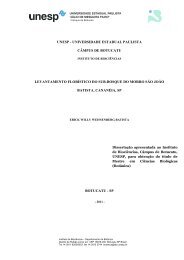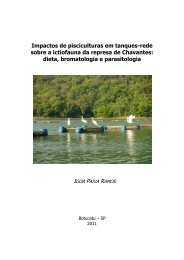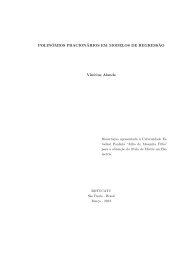Visualizar Tese - Instituto de Biociências - Unesp
Visualizar Tese - Instituto de Biociências - Unesp
Visualizar Tese - Instituto de Biociências - Unesp
You also want an ePaper? Increase the reach of your titles
YUMPU automatically turns print PDFs into web optimized ePapers that Google loves.
<strong>Tese</strong> <strong>de</strong> Doutorado Hirose, G. L., 2009<br />
ABSTRACT:Among the crabs (Ebaliinae) found in Brazil, the genus Persephona is the<br />
most representative. At the moment, 4 species were registered: Persephona crinita<br />
Rathbun, 1931; P. lichtensteinii Leach, 1817; P. mediterranea (Herbst, 1794) and P.<br />
punctata (Linnaeus, 1758). The literature provi<strong>de</strong>s many papers for the larvae of<br />
Leucosioi<strong>de</strong>a, but for the genus Persephona only one <strong>de</strong>scription was ma<strong>de</strong> at this<br />
moment (P. mediterranea), and the others species still unknown about their larval<br />
forms. The purpose of this paper is the <strong>de</strong>scription, re<strong>de</strong>scription and morphologic and<br />
morphometric comparison between early larval stages of species of the subfamily<br />
Eballinae found in the south Atlantic, providing data to assist in the separation and<br />
i<strong>de</strong>ntification of species. The larvae were obtained from ovigerous females of P.<br />
mediterranea, P. lichtensteinii and P. punctata, collected in Ubatuba, São Paulo, Brazil<br />
(23 º 26'S and 45 º 05'W) by bottom trawls between 10 and 15m <strong>de</strong>pth. The drawings<br />
and <strong>de</strong>scriptions ma<strong>de</strong> for the larvae (Zoea I), as well all their appendices were ma<strong>de</strong><br />
using a microscope Zeiss, equipped with a camera lucida. For morphometric analysis,<br />
15 larvae of each species were measured using a Zeiss microscope, equipped with a<br />
image and measure system. Of each larva were taken 8 different morphometric<br />
measures (variables), subsequent the data were submitted to a discriminant function<br />
analysis. Significantly differences among the species were found in relation with the<br />
morphological and morphometric characteristics. These characteristics may help to<br />
elucidate the i<strong>de</strong>ntification of species of Leucosioi<strong>de</strong>a found in the south Atlantic, and<br />
can be an important tool in ecological studies, supporting the i<strong>de</strong>ntification of<br />
planktonic morphotypes, which then can be i<strong>de</strong>ntified at the species level. In general,<br />
very little is known, yet, on the larval forms of Leucosioi<strong>de</strong>a from South Atlantic. This<br />
lack of information hampers the clarification of taxonomic relationships, which are of<br />
fundamental importance for un<strong>de</strong>rstanding the phylogeny of this group.<br />
88
















